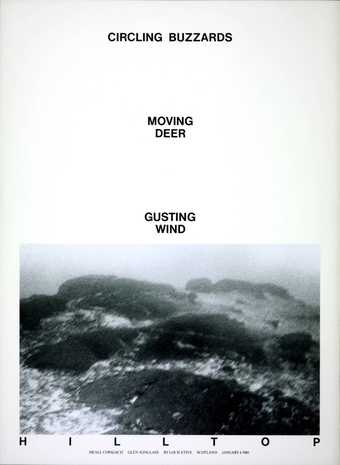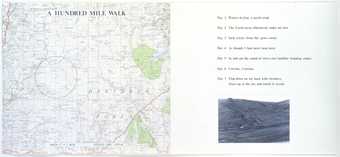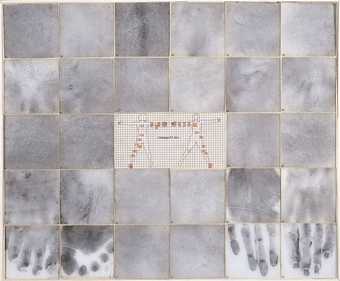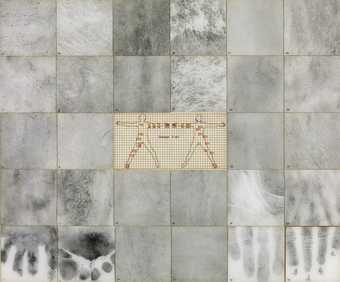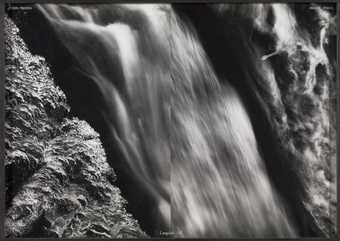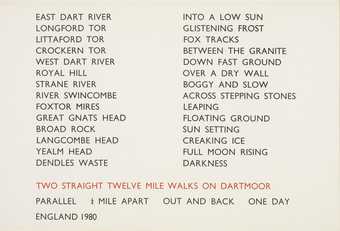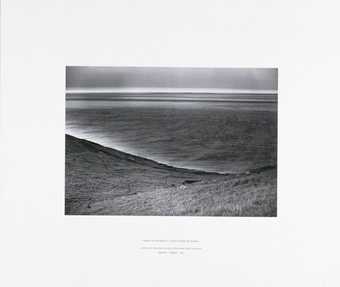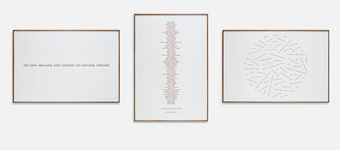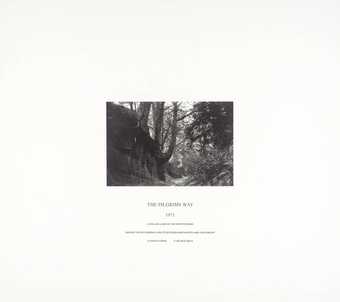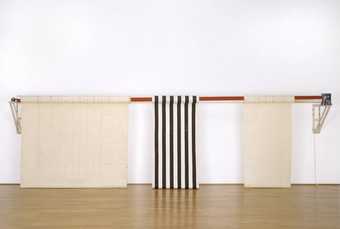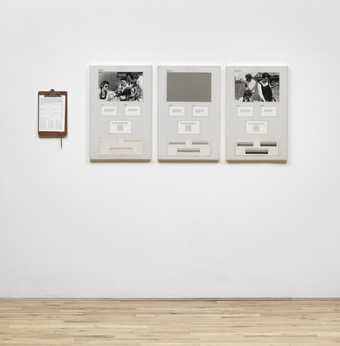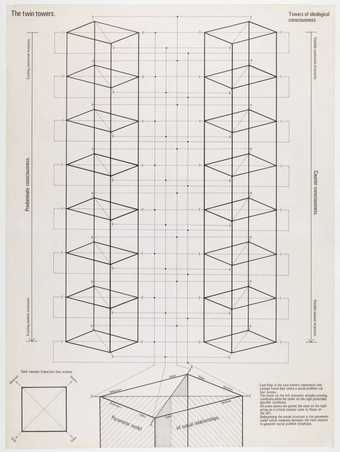
Not on display
- Artist
- Roger Ackling 1947–2014
- Medium
- Burnt lines on board and transfer lettering on card
- Dimensions
- Support: 558 × 367 mm
- Collection
- Tate
- Acquisition
- Presented by the Contemporary Art Society 1983
- Reference
- T03562
Display caption
Ackling draws scorched lines by concentrating the sun’s rays through a hand-held magnifying glass. To obtain the ‘sun lines’ for this work, he stopped at given intervals during a walk up Chillerton Down on the Isle of Wight. These five stages are ‘sunsets’ because each time the sun sank below his immediate horizon line, he had to climb higher to catch sight of it again.
Ackling called this particular work a ‘Country Sketch’ because it was made in the landscape and he wished to invest it with a degree of immediacy and informality.
Gallery label, February 2010
Does this text contain inaccurate information or language that you feel we should improve or change? We would like to hear from you.
Catalogue entry
T03562 FIVE SUNSETS IN ONE HOUR 1978
Burnt lines and Letraset on card mounted on paper-covered card 22 × 14 1/2 (559 × 368)
Letraset inscription ‘A COUNTRY SKETCH/CHILLERTON DOWN ISLE OF WIGHT ENGLAND/JUNE 24 1978’ b.c.
Presented by the Contemporary Art Society 1983
Prov: Purchased from the Lisson Gallery by the Contemporary Art Society, October 1979
Exh: Roger Ackling - Drawings, Lisson Gallery, September–October 1979 (no catalogue, 40 on typed sheet); Contemporary Choice, Serpentine Gallery, October–November 1982 (Art and Artists special issue no.143, 2, p.42)
Lit: Fenella Crichton, ‘London’ (exhibition review), Art and Artists, xiv, November 1979, pp.44–5; artist's statement in Aspects of British Art Today, exhibition catalogue, Metropolitan Art Museum, Tokyo, 1982, p.54
The support for this work consists of a sheet of paper-covered card. On this has been mounted a smaller rectangle of coarse brown woodpulp board measuring 200 × 73 and about 1mm thick. This smaller board carries five short horizontal parallel lines which the artist has burned into it by concentrating the sun's rays through a hand-held magnifying glass. Beneath the scorched lines Ackling has recorded that the work was made at Chillerton Down on the Isle of Wight in June 1978 and above the lines, that the work consists of ‘Five Sunsets in One Hour/Five one minute sun lines’. He has marked each ‘sun line’ with the exact time at which it was made (6.50pm, 7.07pm, 7.15pm, 7.36pm and 7.50pm).
To the left of the lines, and positioned between them, the printed legend ‘Walk up the Hill’ is repeated at five intervals, indicating the artist's ascent of Chillerton Down. Above the top scorched line, he has printed ‘Walk down the Hill’.
The following notes are based on a conversation with the artist (5 March 1986).
Chillerton Down, a hill on the Isle of Wight, is well known to Ackling because it is situated directly behind the house where his parents have lived for the past twelve years and is accessible from their garden. He visits the Isle of Wight at least once a year and makes a work on each trip. (For the past few years he has also been making a private cumulative fixed work near the top of Chillerton Down, which he adds to on each visit.)
To obtain the scorched ‘sun lines’ for T03562, Ackling stopped at given intervals during his walk up Chillerton Down and sat with his back to the setting sun, holding up a magnifying glass at an angle, so as to deflect the rays on to his board. He described these five stages as ‘sunsets’ in the work because each time the sun sank below his immediate horizon line, he had to climb higher to catch sight of it again and to ‘catch’ it in his glass. Thus his ascent paralleled the sun's descent. It seemed to him that the sun set five times as it sank from view and he felt as though he was resurrecting it each time he climbed further up the hill.
During the period when he made T03562, Ackling based all his work on the time scale either of one minute or of one hour. Here he used (as he still does) an ordinary magnifying glass which he trained against a special coarse pulp board for exactly one minute at each stopping point. As he climbed higher and the sun sank, its rays naturally became weaker and, in consequence, the lines become shorter towards the top of the card. The progressive shortening of the lines creates a curve which relates formally but also actually to the curve of the Down; Ackling has also compared it to the curve of the earth's surface, which finally obscures the setting sun.
He has said that for him such works are very specific, having to do with particular times, days, seasons and specific locations, whether made in Great Britain or abroad (he frequently travels abroad to work). In T03562 and other works on card, the card remains the constant factor and it is the combination of hand and lens which determines the length and strength of the lines recorded.
Ackling points out that T03562 also records the wind conditions on the day it was made. The degree and angle of the smudging around each line indicates that the wind was stronger at 6.50pm but had weakened and changed direction by 7.15pm.
Nowadays Ackling works with wood and although his engraving process remains the same he gives precedence to images in the newer pieces and does not supply written information on the works themselves. However, as with all his work, he sees T03562 as part of a total experience of landscape and has pointed out that by harnessing the sun he is channelling energy but also releasing it back into the atmosphere through burning. He also remains aware of the scale of man within a universal scale (‘the grid inside oneself is the same grid that the earth is composed of’).
Ackling called T03562 a ‘Country Sketch’ because it was made in the landscape and he wished to invest it with the immediacy and informality of a more traditional landscape sketch in situ.
On the same visit to the Isle of Wight in 1978 Ackling made one other work which he has compared to ‘Five Sunsets in One Hour’. It was also exhibited at the Lisson Gallery in September–October 1979 (‘The Sun Over My Right Shoulder, September'78’, 33, on typed sheet), and was made at Barndown, a site near Chillerton Down.
This entry has been approved by the artist.
Published in:
The Tate Gallery 1982-84: Illustrated Catalogue of Acquisitions, London 1986
Explore
- abstraction(8,615)
-
- non-representational(6,161)
-
- text(1,043)
- universal concepts(6,387)
-
- environment / nature(315)
- time(679)
- UK counties(19,585)
-
- Isle of Wight(259)
- England(19,202)
- England, South East(5,940)
- England, Southern(8,982)
You might like
-
Richard Long CBE In the Cloud
1991 -
Hamish Fulton Slioch Hilltop Cairn/Circling Buzzards
1980 -
Richard Long CBE A Hundred Mile Walk
1971–2 -
Judy Clark Catalogue [female symbol] 3 Skin
1973 -
Judy Clark Catalogue [male symbol] Skin
1973 -
John Hilliard Langdale Fell, Motion Frozen/Frozen Motion
1979 -
Richard Long CBE Two Straight Twelve Mile Walks on Dartmoor, England 1980
1980 -
Hamish Fulton France on the Horizon
1975 -
Richard Long CBE Ten Days Walking and Sleeping on Natural Ground
1986 -
Hamish Fulton The Pilgrim’s Way
1971 -
John Latham Time-Base Roller
1972 -
Richard Long CBE Watershed
1992 -
Victor Burgin 25 feet two hours
1969 -
Stephen Willats ‘The Lunch Triangle’: Pilot work B. Codes and Parameters
1974 -
Stephen Willats The Twin Towers
1977


